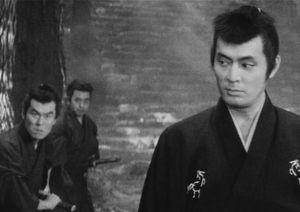The Sword of Doom (April 11/05)
 Given the incredibly abrupt conclusion - think Son of the Blob - it seems fairly obvious that The Sword of Doom was originally conceived to be the first part in an ongoing series of films. But a sequel never happened, and given the recent death of director Kihachi Okamoto, it's highly unlikely that one ever will. Then again, aside from several admittedly impressive action sequences, there's not a whole lot here worth recommending.
Given the incredibly abrupt conclusion - think Son of the Blob - it seems fairly obvious that The Sword of Doom was originally conceived to be the first part in an ongoing series of films. But a sequel never happened, and given the recent death of director Kihachi Okamoto, it's highly unlikely that one ever will. Then again, aside from several admittedly impressive action sequences, there's not a whole lot here worth recommending.
The film follows several characters as they navigate the treacherous waters of 19th century Japan - particularly a vicious warrior named Ryunosuke Tsukue (Tatsuya Nakadai) and the granddaughter of one of his victims (played by Yôko Naito). Though the opening half hour revolves around Tsukue, screenwriter Shinobu Hashimoto begins introducing several interconnected subplots as the movie progresses - yet none of them are as compelling or intriguing as Tsukue's tale.
And that's really the problem here. Despite a plethora of characters, there are only one or two that are interesting enough to warrant more than a few minutes worth of screen time. As a result, The Sword of Doom works best when it's dealing with Tsukue - a seemingly heartless killing machine who is, unfortunately, woefully underdeveloped. There's a good chance the character's backstory would've been explored in the planned sequels, particularly given the manner in which the movie ends (there's so much left unanswered in regards to Tsukue and what motivates him).
The Sword of Doom's saving grace, then, involves Okamoto's masterful sense of style, which - in many cases - is just about the only captivating aspect of the film. This is especially true of the movie's three major fight sequences, which are exceedingly entertaining (one such scene, featuring Tsukue as he confronts a dozen assailants in a single, uninterrupted take, seems to have inspired a similar sequence in Chan-wook Park's Old Boy). Okamoto effectively imbues the film with a distinctive and constantly evolving look that's enhanced by cinematographer Hiroshi Murai's stark black-and-white photography, yet the visuals just aren't enough to disguise the fact that there's no real flow or sense of pacing at work here.